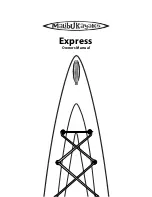
53
Blisters are a continuing topic with respect to fiberglass hulls. Whether or not they appear
depends on a myriad of variables. But they can and will develop blisters if they remain in the
water too long. If they do, deal with them early. One of the vinylester epoxy bottom jobs being
performed in the Chesapeake Bay in the early 80s has left hull #107's bottom, baby bottom
smooth ever since. When you haul out, keep an eye out for the first little pinhead blisters. These
are normally only in the gelcoat. It is easier to deal with these than wait until larger, deeper
blisters begin to appear. The softer bottom paints that slough off (Micron, CSC, etc.) are easy to
prep for a new paint job when you haul every 1-3 years, depending on where you live and whether
you like to race or not. Some of the harder bottom paints (Trinidad types) that accumulate over
time do better at repelling heavy barnacle growth in some geographical regions. Ask around
before you buy your next choice of paints. Usually three gallons will cover a V-42 bottom with 2
to 2 ½ coats, if you roll it on. It is a good idea to inspect the bottom periodically. In areas such as
the Chesapeake Bay, groundings are generally not serious as the muddy bottom is unlikely to do
any serious damage. However, in the Caribbean and Northwest cruising areas, for example,
groundings on rock and coral are a different matter. If possible, the hull should be inspected
immediately after a hard grounding on rock or coral. If deep scrapes are found or if the fiberglass
has actually been crushed or distorted, the yacht should be hauled at your earliest convenience and
the damaged fiberglass repaired. While we do not wish to exaggerate the potential for water to
soak into the damaged surface, the possibility is there, and immediate repair is very important to
limit the area of potential water saturation.
Your Tayana 42 comes with a heavy rub rail which bolted and/or glued to the side with either a
bronze or stainless steel striker to protect the sides. It is a thing of beauty when properly
maintained and a wise investment that will take a great deal of the abuse which otherwise would
have to be absorbed by the hull. The rub rail is very often neglected during cleaning. It should be
cleaned, sanded, and preserved in the same manner as other teak on the yacht. (See discussion
below.)
B. The Deck and Cabin Top
The deck and cabin top of the Tayana 42 is molded in essentially the same manner as the hull -
in a one piece mold following the fiberglass. When the deck is removed from the mold, most of
the teak trim is installed before the deck and hull are joined. Teak decks, teak facings on the
cabin, and teak in the cockpit are all installed before the deck is joined to the hull. The fiberglass
of the deck and the cabin are cleaned and maintained in the same manner as the hull. Any one of
several good cleaners and waxes will tend to help keep colors bright and new looking. The big job
will be teak maintenance. In the old days, teak decks were maintained with a holystone and salt
water. The holystone was a large piece of pumice rock that was rubbed across the deck to clean
and polish wood. When done regularly, the teak was kept a beautiful silvery color which was
quite striking when contrasted with the painted surfaces and natural wood colors. The salt water
helped keep the teak in good shape because salt would be left in the wood as the water
evaporated. Because the salt was slightly hygroscopic (attracts moisture), the teak did not dry out
rapidly. Of course, wetting and cleaning had to be done daily if the deck was to be kept in the best
condition. Not many people are going to holystone their teak daily in this day and age, although
Содержание VANCOUVER 42
Страница 1: ...1 OPERATIONS AND MAINTENANCE MANUAL TAYANA VANCOUVER 42...
Страница 2: ...2 Tayana V 42 Center Cockpit Sailplan...
Страница 3: ...3 Tayana V 42 Aft Cockpit Interior Layout...
Страница 12: ...12 Figure II 1 Fiberglass Layout Schedule...
Страница 13: ...13 Figure II 2 V 42 Deck and Hull Joint...
Страница 19: ......
Страница 37: ...37 Figure IV 1 Fuel Supply Plumbing...
Страница 38: ...38 Figure IV 2 Fluid Plumbing System...
Страница 39: ...39 Figure IV 3 Center Cockpit Tankage Diagram...
Страница 43: ...43 TABLE IV 1 Direct Current Energy Audit...
Страница 48: ...48 Figure IV 6 Waste Water Plumbing System...
Страница 51: ...51 Figure IV 8 Propane System...












































